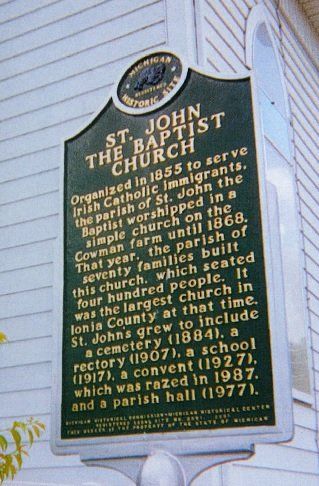A perfect example of immigrants sacrificing to build a secure religious foundation for their children is the story of our own parish beginnings. One hundred fifty-six years ago in 1849, John Cowman, the first Irish Catholic immigrant walked this fertile land of North Plains Township. One mile west of town he staked his future, our future. His converted sheep-shed was our first church and his hilltop meadow, our first cemetery. In 1855, with the help of Father Godez of Westphalia, St. John the Baptist Parish was registered with the Detroit Diocese, the only one in Michigan at that time.
"Love of life, fierce pride in national heritage, strong religious belief and a sparkling sense of humor--all of these qualities are associated with the Irish people." And they are no better represented than here in Hubbardston where seven immigrant families, the first arriving in 1849, grew to 70 families in 1868 when they erected this "architectural perfection" and called it St. John the Baptist on Fish Creek. This building, the largest in Ionia County in 1868, seating 400-600 people (by various accounts), constructed by ship-builders brought in to hand the trusses, holds the record for the church longest in continuous operation in Grand Rapids Diocese. It was built at a cost of $8000 by Irish immigrant families (Ionia Sentinel Standard, June 1868).
In 1888, the Dominican Sisters of Racine, Wisconsin arrived and our Catholic school system was established. It functioned to perfection until 1964 when vocations diminished and teaching Sisters were no longer available. A credit to our priests, these teaching Sisters and our devoted families are the fifteen priests who were ordained from St. John the Baptist Parish and the twenty-three Sisters, daughters of the parish, who dedicated their lives to their Catholic faith in various convents throughout the area.
For 156 years starting with Father Godez of St. Mary's Church in Westphalia, the only Catholic parish within 100 miles of Hubbardston, St. John the Baptist has been fortunate enough to have had a parish priest to guide the families calling "Fish Creek," "Plains," and finally "Hubbardston" their home. Because of its size (70 families in 1868), three parishes were formed from the original Hubbardston Parish.
In the late 1880's Bishop Henry Richter ordered the parishioners north of the Montcalm County line to form a new parish in Carson City and charged Dennis O'Connell of Hubbardston to be the good will ambassador convincing members that the new St. Mary's Parish could be accomplished and comfortable for the practice of their faith. Shortly after the turn of the century, the portion of St. John the Baptist Parish south of the Brick Schoolhouse Road was ordered to form a new division to be called St. Joseph's Parish of Pewamo.
In 1905, eighteen stained glass windows measuring approximately three feet by twelve feet were installed with funds secured by farmers heading into the northern woods of Michigan for work at the 'logging camps' on New Years Day each year and returning on Holy Saturday, the day before Easter Sunday.
In 1907 an $8000 Rectory was added. In 1918 a full twelve grade Catholic School was built and remained fully operational until September, 1965. In 1927 an impressive English Gothic design convent was added as a home for the teaching Sisters of St. Dominic from Racine, Wisconsin.
Father Bolte (1855-1869) was our first parish priest, followed by fourteen others; ending with Father William Reitz (1986-2004) who retired September 24, 2005 at age 82 after hip surgery limited his activity. Presently, Ms. Nancy Woodcock is our much loved, devoted and very capable parish administrator. St. John's and St. Mary's have been combined due to lack of priests and the irony is that Father Mason of St. Joseph's in Pewamo steps in on occasion to fill our priestly needs. What is old is new again, but the faith never diminishes. We are blessed as a people and a parish.
On January 18, 2001 St. John the Baptist Parish was designated a Michigan Historical Site and on September 24, 2001, the parish complex was officially listed on the National Register of Historic Places. Listing in the National Register provides recognition that this Irish Catholic Parish Complex is significant to the nation, to the state and to the community. "The National Register is the federal government's official list of properties deemed worthy of preservation because of their importance in American History and culture. Listing in the National Register provides recognition and assists in preserving our national heritage." (Bruce Conway, State Historic Preservation Officer)
--Joanne Burns Howard



